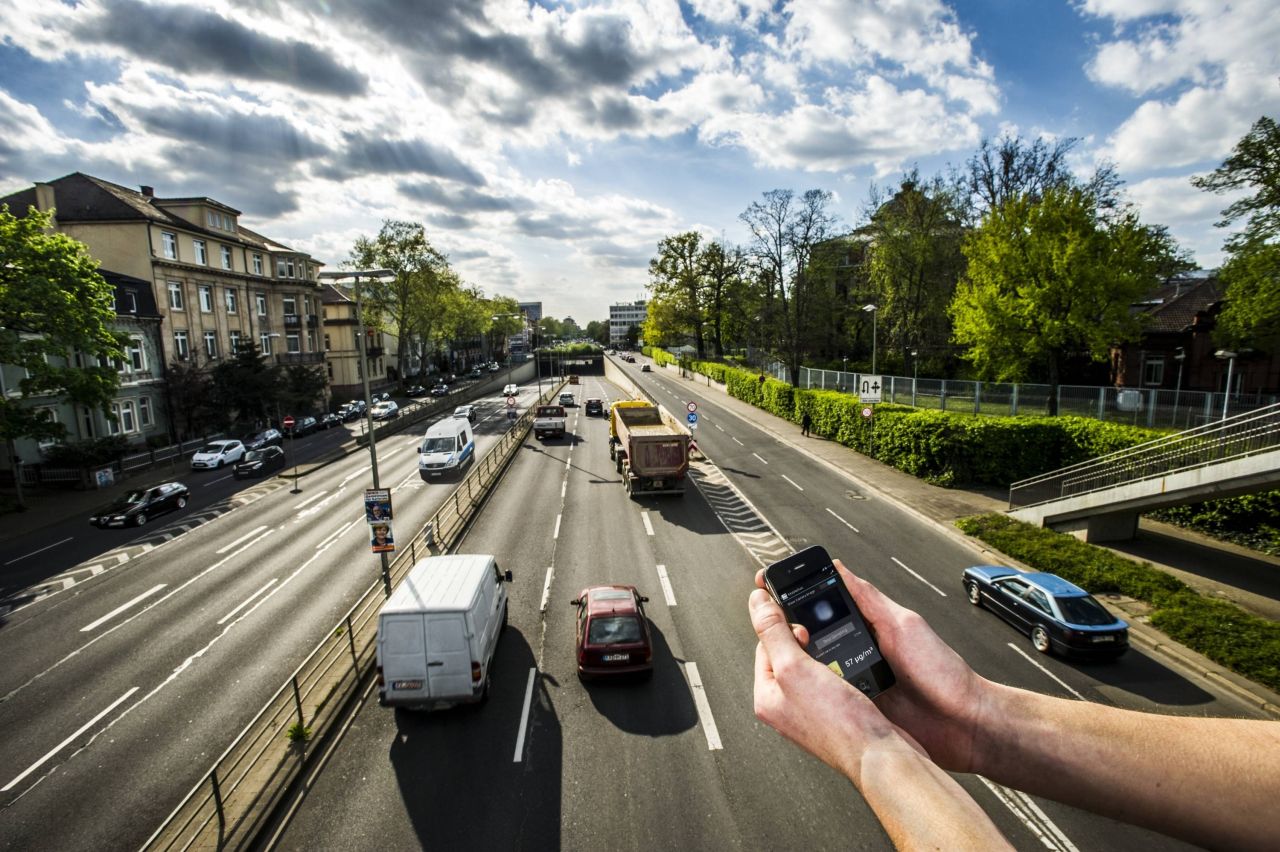KIT researchers are currently developing a closely meshed network for predicting air quality with a high temporal and spatial resolution. The new measurement and analysis system does not only pool existing meteorological and traffic data as well as air quality data measured by stations, but also data recorded by flights of drones and fine dust measurements of citizens with the help of specially equipped smartphones, for instance. The SmartAQnet project coordinated by Karlsruhe Institute of Technology (KIT) is funded with EUR 2.9 million by the Federal Ministry of Transport and Digital Infrastructure (BMVI).
Worldwide, more than half of the population lives in cities. In Germany, this holds for more than three quarters of the population. For their health, air quality is of crucial importance. However, distributions of pollutants, such as fine dust, in the urban atmosphere vary considerably. Highly precise, expensive measurement stations can be found at a few critical points, where air pollution is very high, examples being Neckartor in Stuttgart or Landshuter Allee in Munich. So far, information on air pollution in the own quarter or on the way to the working place has not been available to the individual citizen. The Smart Air Quality Network (SmartAQnet) project is aimed at developing a system to better understand the distribution of fine dust in the city, with Augsburg being the first model region. Within the framework of the KIT-coordinated project with partners from industry, science, and the city, existing datasets are pooled and combined with an interconnected mobile measurement strategy.
“We try to pool all available data and complement them by a multi-level network of sensors to improve the dataset,” says project head Matthias Budde, computer scientist at the Chair for Pervasive Computing Systems (PCS) and member of the TECO research group.
The Chair works on efficient methods to evaluate large data volumes and convert them into usable knowledge. It is headed by Professor Michael Beigl, Spokesperson of the Smart Data Innovation Lab (SDIL), one of three big data competence centers in Germany established with federal funds. Within SmartAQnet, the data collected do not only include air and weather data of classical measurement stations, but also measurements by drones, i.e. information on the fine dust distribution in higher air layers, and measurement data of citizens measuring urban air pollution with low-cost sensors. Budde has developed a plug-in sensor and an app to turn the camera of a smartphone into a fine dust detector. The flash of the smartphone emits light into the measurement area. This light is scattered by the fine dust. The camera captures the measurement result in the form of a picture. From its brightness, the dust concentration can be calculated. Simple technology for measurement by non-experts may be less precise, but this drawback is compensated by the large number of measurements and the wide area covered.
Evaluation of the data measured by a variety of instruments, from stationary, scientific high-precision devices to low-cost systems that can be operated easily by non-experts, is one of the challenges of the project. “For this purpose, smart algorithms and big data analyses are required,” Budde says. SmartAQnet focuses on the development of a platform into which the project partners input their measurements. “Except for personal data, all data collected by researchers and citizens will be made available to the interested public as open data,” Budde adds. The data can then be used by scientists, urban planners, authorities, and citizens.
“Urban climate researchers are highly interested in large-area measurements to obtain a complete picture of air quality,” says Professor Stefan Emeis, climate researcher of KIT’s Institute for Meteorology and Climate Research (IMK), a partner of SmartAQnet. Findings obtained from the SmartAQnet project will be used among others by climate researchers for numerical simulation under the “Urban Climate under Change” program funded by the Federal Ministry of Education and Research (BMBF). SmartAQnet is considered a promising project to understand which parts of the city are subjected to which levels of pollution, Emeis points out. Augsburg is a suitable model region, because a number of environmental institutions are located there and stationary measurement instruments have been installed, whose long-term data can be incorporated in the project.
The SmartAQnet project that started in spring 2017 has a duration of three years. The cooperation project is funded by the Federal Ministry of Transport and Digital Infrastructure (BMVI) with EUR 2.9 million from funds for digital, data-based innovations. Of these, the KIT institutes involved are granted about EUR 500,000 each. Other partners are Aerosol Akademie e.V. that operates an interdisciplinary network for aerosol technology and aerosol research, GRIMM Aerosol Technik GmbH & Co. KG, a highly renowned globally acting enterprise in the area of environmental and industrial safety measurements, Augsburg University with the Chair for Physical Geography and Quantitative Methods (IGUA) of its Institute of Geography, and two working groups of Helmholtz Zentrum München, German Research Center for Environmental Health (HMGU): The Institute of Epidemiology II and the Comprehensive Molecular Analytics Group (CMA). The Environmental Office of the city of Augsburg supports the project as an associated partner.
More information:
http://smartaq.net/ (in German only)
More about the KIT Climate and Environment Center: http://www.klima-umwelt.kit.edu/english
Being “The University in the Helmholtz Association”, KIT creates and imparts knowledge for the society and the environment. It is the objective to make significant contributions to the global challenges in the fields of energy, mobility, and information. For this, about 10,000 employees cooperate in a broad range of disciplines in natural sciences, engineering sciences, economics, and the humanities and social sciences. KIT prepares its 22,800 students for responsible tasks in society, industry, and science by offering research-based study programs. Innovation efforts at KIT build a bridge between important scientific findings and their application for the benefit of society, economic prosperity, and the preservation of our natural basis of life. KIT is one of the German universities of excellence.

